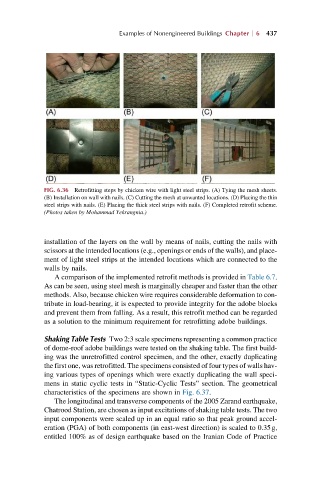Page 494 - Advanced Design Examples of Seismic Retrofit of Structures
P. 494
Examples of Nonengineered Buildings Chapter 6 437
FIG. 6.36 Retrofitting steps by chicken wire with light steel strips. (A) Tying the mesh sheets.
(B) Installation on wall with nails. (C) Cutting the mesh at unwanted locations. (D) Placing the thin
steel strips with nails. (E) Placing the thick steel strips with nails. (F) Completed retrofit scheme.
(Photos taken by Mohammad Yekrangnia.)
installation of the layers on the wall by means of nails, cutting the nails with
scissors at the intended locations (e.g., openings or ends of the walls), and place-
ment of light steel strips at the intended locations which are connected to the
walls by nails.
A comparison of the implemented retrofit methods is provided in Table 6.7.
As can be seen, using steel mesh is marginally cheaper and faster than the other
methods. Also, because chicken wire requires considerable deformation to con-
tribute in load-bearing, it is expected to provide integrity for the adobe blocks
and prevent them from falling. As a result, this retrofit method can be regarded
as a solution to the minimum requirement for retrofitting adobe buildings.
Shaking Table Tests Two 2:3 scale specimens representing a common practice
of dome-roof adobe buildings were tested on the shaking table. The first build-
ing was the unretrofitted control specimen, and the other, exactly duplicating
the first one, was retrofitted. The specimens consisted of four types of walls hav-
ing various types of openings which were exactly duplicating the wall speci-
mens in static cyclic tests in “Static-Cyclic Tests” section. The geometrical
characteristics of the specimens are shown in Fig. 6.37.
The longitudinal and transverse components of the 2005 Zarand earthquake,
Chatrood Station, are chosen as input excitations of shaking table tests. The two
input components were scaled up in an equal ratio so that peak ground accel-
eration (PGA) of both components (in east-west direction) is scaled to 0.35g,
entitled 100% as of design earthquake based on the Iranian Code of Practice

